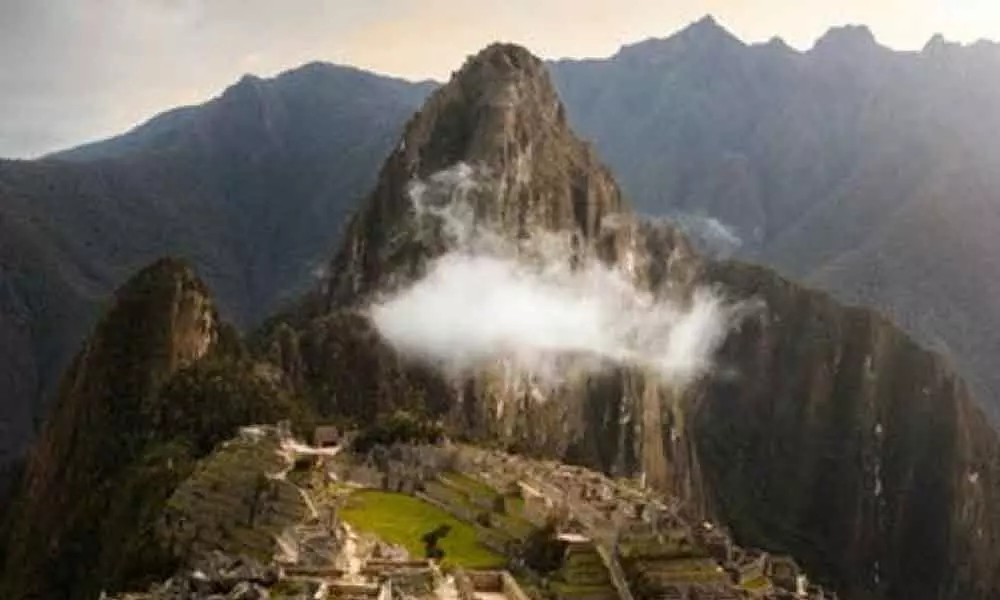Live
- 3 including 2 women held in murder case
- SP slams UP govt, calls it orchestrated
- Shot In The Arm For Tribals… Girijan Coop Corpn Ropes In City Firm To Digitalise Petrol Bunks
- Complete failure of UP govt: Congress
- ‘Excavation rumour sparked violence, SDM, CO responsible’
- Cinematic legacy celebrated at SV University
- No permission needed for buildings up to 15 metres
- Do you support caste census? Which one will you prefer caste census or skill census?
- GHMC Commissioner attends Prajavani, receives 126 applications
- 6 injured as lift crashes in Bahadurpura apartment
Just In

Study says Machu Picchu's Incan sanctuary intentionally built on faults.
Washington: While the ancient Incan sanctuary of Machu Picchu is known to be one of the best architectural achievements of man, researchers also believe that its construction is due to geological faults that lie beneath the site. At the GSA Annual Meeting in Phoenix, Rualdo Menegat, a geologist at Brazil's Federal University of Rio Grande do Sul, presented the results of a detailed geoarchaeological analysis that suggested the Incas intentionally built Machu Picchu as well as some of their cities in locations where tectonic faults meet.
"Machu Picchu's location is not a coincidence," said Menegat. "It would be impossible to build such a site in the high mountains if the substrate was not fractured." Using a combination of satellite imagery and field measurements, Menegat mapped a dense web of intersecting fractures and faults beneath the UNESCO World Heritage site.
His analysis indicated these features vary widely in scale, from tiny fractures visible in individual stones to major, 175-kilometre-long lineaments that control the orientation of some of the region's river valleys. Menegat found that these faults and fractures occur in several sets, some of which correspond to the major fault zones responsible for uplifting the Central Andes Mountains during the past eight million years.
Because some of these faults are oriented northeast-southwest and others trend northwest-southeast, they collectively create an "X" shape where they intersect beneath Machu Picchu. Menegat's mapping suggested that the sanctuary's urban sectors and the surrounding agricultural fields, as well as individual buildings and stairs, are all oriented along with the trends of these major faults. "The layout clearly reflects the fractured matrix underlying the site," said Menegat.
Other ancient Incan cities, including Ollantaytambo, Pisac, and Cusco, are also located at the intersection of faults, said Menegat. "Each is precisely the expression of the main directions of the site's geological faults." Menegat's results indicated the underlying fault-and-fracture network is as integral to Machu Picchu's construction as its legendary stonework.
This mortar-free masonry features stones so perfectly fitted together that it's impossible to slide a credit card between them. As master stoneworkers, the Incas took advantage of the abundant building materials in the fault zone, said Menegat. "The intense fracturing there predisposed the rocks to break along these same planes of weakness, which greatly reduced the energy needed to carve them."
In addition to helping shape individual stones, the fault network at Machu Picchu likely offered the Incas other advantages, according to Menegat. Chief among these was a ready source of water. "The area's tectonic faults channeled meltwater and rainwater straight to the site," he said. Construction of the sanctuary in such a high perch also had the benefit of isolating the site from avalanches and landslides, all-too-common hazards in this alpine environment, Menegat explained.
The faults and fractures underlying Machu Picchu also helped drain the site during the intense rainstorms prevalent in the region. "About two-thirds of the effort to build the sanctuary involved constructing subsurface drainages," said Menegat. "The preexisting fractures aided this process and help account for its remarkable preservation," he said. "Machu Picchu clearly shows us that the Incan civilization was an empire of fractured rocks."

© 2024 Hyderabad Media House Limited/The Hans India. All rights reserved. Powered by hocalwire.com







